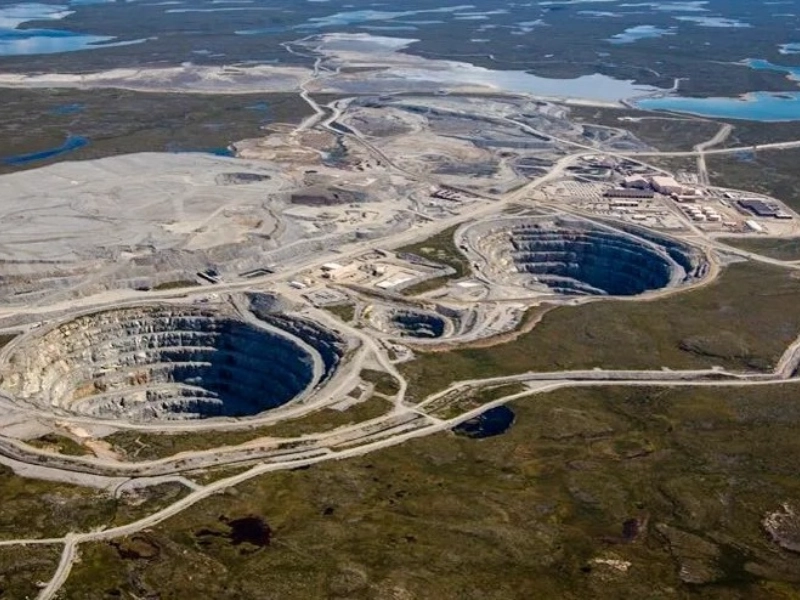Digging for Billions: Inside the World's Mega Diamond Mines
Advertisement
6. Ekati Diamond Mine (Canada)

Advertisement
One of the first diamond mines in Canada, the Ekati Diamond Mine is a trailblazing player in the diamond sector. About 300 kilometres north-east of Yellowknife, in the isolated and unspoilt terrain of the North-west Territories, Ekati has been instrumental in helping Canada become a major actor on the world diamond scene. Reflecting its position in the Lac de Gras region, an area rich in diamond-bearing kimberlite pipes, the mine's name, "Ekati," means "fat lake" in the Tlicho language.
Originally found by geologists Chuck Fipke and Stewart Blusson in 1991, Ekati signalling the start of Canada's diamond frenzy. In a few years, this discovery turned Canada from a non-producer to among the top diamond-producing countries in the world. Originally owned by BHP Billiton, the mine started commercial operation in 1998; it has since passed hands and is now run by Arctic Canadian Diamond Company.
The importance of Ekati goes much beyond its position as a trailfinder. Setting criteria for environmental responsibility, community involvement, and ethical mining methods, the mine has been crucial in forming Canada's diamond business. Its success confirmed Canada's place in the world diamond market and opened the path for subsequent Canadian diamond mines like Diavik and Gahcho Kué.
Operating in one of the most difficult places on Earth, the mine battles subarctic conditions whereby winter temperatures may drop to -50°C. Ekati handles around 4.5 million tonnes of ore yearly, generating roughly 3-4 million carats of diamonds under these extreme circumstances. High-quality diamonds from the mine are well-known; among them are a sizable number of big, valuable white diamonds and gorgeous yellow diamonds, which are much sought after on the worldwide market.
The economy of the North-west Territories has been profoundly changed by Ekati. Being a key job provider in the area, the mine has concentrated especially on local hiring and skill development—especially for Indigenous people. By means of several Impact Benefit Agreements with Indigenous organisations, Ekati has guaranteed that a sizable share of its economic gains—including royalties, business contracts, and employment possibilities—find their way back to local communities. This strategy has established a standard for Indigenous participation in the Canadian mining industry, therefore encouraging economic growth and capacity building in far-off northern towns.
From its founding, Ekati has given environmental stewardship top attention. Working in the delicate tundra ecosystem calls for strict environmental control strategies. The mine runs thorough initiatives for air quality monitoring, water control, and animal conservation. Participating in the Diavik-Ekati Caribou Monitoring Programme, which tracks the movements and health of caribou herds in the area and provides important data to support wildlife protection, is one of Ekati's most well-known environmental projects.
Discussions about closure and reclamation have taken front stage as Ekati approaches the later phases of its mine life. Developed in line with local communities and regulatory agencies, the closure strategy for the mine seeks to restore the site to a stable state supporting traditional land use and wildlife. This covers ideas for the slow flooding of open pits to provide fish habitats and native plant species' revegetation of damaged areas.
Ekati's legacy goes much beyond only its financial contributions. Establishing Canada's reputation as a supplier of responsibly produced, conflict-free diamonds has been much aided by the mine. The growth of Ekati resulted in the CanadaMarkTM certification, which assures ethical manufacture and Canadian origin of a diamond. Attracting consumers increasingly worried about the ethical sourcing of their jewellery, this project has helped Canadian diamonds become a premium product on the worldwide market.
Looking ahead, even although Ekati's initial mine plan is almost finished, investigation in the nearby area is ongoing for further diamond-bearing kimberlites that might prolong the life of the operation. The success of the mine has also encouraged more diamond exploration throughout North Canada, maybe resulting in fresh finds and preserving Canada's standing in the world diamond market for years to come.
Ultimately, the Ekati Diamond Mine is evidence of Canada's growing importance as a significant diamond producer. Its influence on the national economy, part in establishing guidelines for ethical mining methods, and support of local and Indigenous populations have been quite significant. Ekati's legacy will surely still shape the direction of diamond mining in Canada and abroad as the worldwide diamond sector develops.
Advertisement
You May Like

